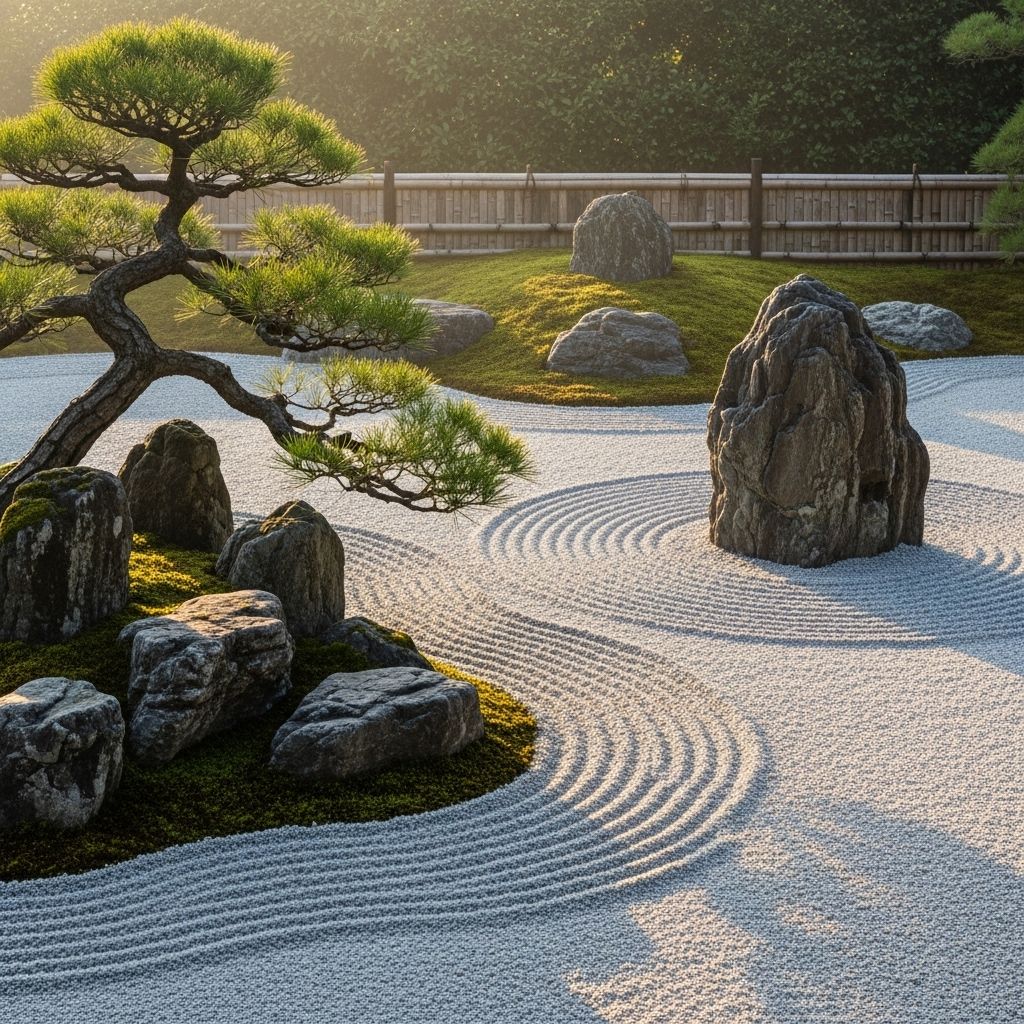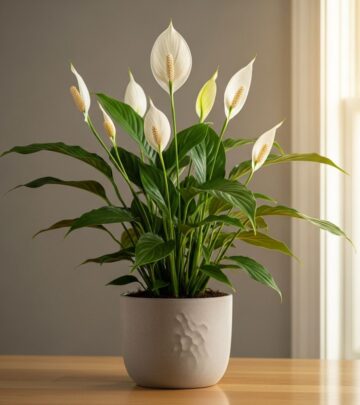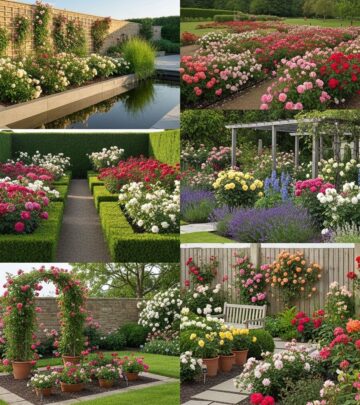Zen Garden Design: 7 Principles for a Tranquil Retreat
Design a peaceful retreat that nurtures calmness and sharpens focused awareness daily.

Image: HearthJunction Design Team
Creating a Zen Garden: A Path to Tranquility and Mindfulness
In today’s fast-paced world, finding moments of peace and tranquility has become increasingly valuable. Zen gardens, with their serene landscapes and mindful design, offer a sanctuary for reflection and meditation right in your own backyard. These Japanese-inspired gardens embody centuries-old principles that balance simplicity with profound meaning, creating spaces that soothe the soul and quiet the mind.
Whether you have a sprawling yard or just a small corner to dedicate to mindfulness, understanding the philosophy and elements of Zen gardens can help you create your own peaceful retreat. This guide will walk you through the history, principles, and practical steps to design and maintain a Zen garden that resonates with authenticity and purpose.
What Is a Zen Garden?
A Zen garden, also known as a Japanese rock garden or ‘karesansui’ (dry landscape), is a minimalist dry landscape that uses natural elements to create a meditative space. These gardens originated in medieval Japan and were influenced by Zen Buddhism, which emphasizes simplicity, mindfulness, and the beauty found in imperfection.
Traditional Zen gardens typically focus on rocks, gravel, and sand rather than lush plantings. They usually feature an enclosed space separated from the outside world by walls or fences, creating a protected environment for contemplation. The arrangement of elements in these gardens is never random but carefully designed to represent natural landscapes like mountains, islands, and flowing water in abstract form.
The Philosophy and Principles of Zen Gardens
At the heart of Zen garden design lies a set of principles that guide not just the aesthetic but also the philosophical approach to creating these spaces. Understanding these principles will help you create a garden that truly embodies the Zen spirit:
Simplicity (Kanso)
Zen gardens embrace minimalism, removing unnecessary elements to reveal the essential beauty of what remains. This principle encourages the elimination of clutter and the creation of clean, unobstructed spaces that allow the mind to find clarity.
Naturalness (Shizen)
Despite being highly designed, Zen gardens should appear as though they emerged naturally from the landscape. Elements should be arranged to feel organic rather than artificial, even when representing abstract concepts.
Asymmetry (Fukinsei)
Unlike Western gardens that often emphasize symmetry, Zen gardens deliberately embrace asymmetrical arrangements. This imbalance creates dynamic tension and reflects the imperfect nature of the world, a concept central to Zen philosophy.
Subtlety (Yugen)
Yugen refers to the quality of mystery and depth that suggests more than what is immediately visible. A well-designed Zen garden hints at deeper meanings and invites contemplation rather than revealing everything at once.
Empty Space (Ma)
The concept of ‘ma’ or negative space is crucial in Zen design. These intentional empty areas are not voids but active design elements that give breathing room to other features and invite the viewer to fill in the blanks with their imagination.
Tranquility (Seijaku)
The ultimate goal of a Zen garden is to create a sense of tranquility and stillness. Each element should contribute to an atmosphere of calm that facilitates meditation and mindfulness.
Austerity (Koko)
This principle embraces the beauty found in aging and weathered objects. In Zen gardens, this might mean incorporating moss-covered stones or weathered wood to evoke a sense of time and impermanence.
Essential Elements of a Zen Garden
While each Zen garden is unique, certain elements are commonly found in these contemplative spaces. Understanding how these components work together will help you design a cohesive and authentic garden:
Rocks and Stones
Rocks are perhaps the most important elements in a Zen garden, often representing mountains, islands, or animals in the landscape. They should be carefully selected for their shape, texture, and character, then positioned with intention. In traditional design, rocks are typically arranged in groups of three, five, or seven, creating natural-looking compositions that draw the eye through the garden.
Gravel and Sand
The foundation of many Zen gardens is a bed of fine gravel or sand that is raked into patterns representing water, waves, or ripples. This element not only provides visual interest but also serves as a canvas for meditative raking practices. The act of creating and maintaining these patterns becomes a form of moving meditation that helps cultivate mindfulness.
Water Features
While traditional dry Zen gardens represent water symbolically through raked gravel, contemporary interpretations sometimes incorporate actual water features like small ponds, streams, or fountains. The sound of flowing water adds another sensory dimension that enhances the peaceful atmosphere.
Plants and Moss
Plants in Zen gardens are used sparingly and with purpose. Evergreens like pines and junipers are favored for their year-round presence and symbolic association with longevity. Moss often serves as a living carpet that softens the appearance of rocks and adds a sense of age and established harmony to the garden.
Vertical and Horizontal Elements
The interplay between vertical features (like standing rocks, bamboo, or trees) and horizontal elements (such as stone gardens or ground cover) creates visual interest and represents the balance between heaven and earth in traditional Japanese philosophy.
Enclosure
Most Zen gardens include some form of enclosure—be it a fence, wall, or hedge—that separates the contemplative space from the outside world. This boundary helps create a sense of sanctuary and focuses attention inward.
Ornaments and Accessories
Traditional Japanese ornaments like stone lanterns, water basins, or bridges may be incorporated as focal points or transitional elements. However, these should be used sparingly to maintain the garden’s simplicity and avoid creating visual clutter.
How to Create Your Own Zen Garden
Creating a Zen garden is a deeply personal process that should reflect your own connection to these principles while honoring the traditions that inspire them. Here’s a step-by-step approach to designing your own meditative space:
Choose the Right Space
Select a location that feels naturally peaceful and separate from high-traffic areas. This can be a dedicated section of your yard, a corner of your garden, or even a balcony or terrace in urban settings. The size doesn’t matter as much as finding a spot where you can easily access and enjoy your garden regularly.
Plan Your Design
Before breaking ground, sketch your ideas and consider how different elements will work together. Think about viewpoints, movement through the space, and how the garden will look in different seasons. Remember that simplicity is key—it’s often better to include fewer elements with more intention than to overcrowd the space.
Prepare the Site
Clear the area of existing vegetation and debris, then establish proper drainage to prevent water accumulation. If your garden will include a gravel or sand base, consider installing landscape fabric to prevent weed growth before adding these materials.
Select and Place Your Rocks
Choose rocks with interesting shapes, textures, and character. Place larger rocks first, burying them partially to create a natural, established look. Group them according to traditional principles, creating compositions that feel balanced yet asymmetrical.
Add Gravel and Sand
Spread a layer of fine gravel or sand throughout the garden area, then rake it into patterns that complement your rock arrangements. Traditional patterns include straight lines, concentric circles around rocks, or wave-like curves that create a sense of movement.
Incorporate Plants Thoughtfully
Select plants that embody the Zen aesthetic—typically evergreens, bamboo, or Japanese maples that provide year-round interest with minimal maintenance. Plant them sparingly, allowing each specimen room to be appreciated individually.
Consider Pathways
If your garden includes areas for walking, create pathways using stepping stones or more gravel to guide movement through the space. These paths should feel natural and encourage mindful walking rather than hurried passage.
Add Final Touches
Carefully incorporate any additional elements like lanterns, water features, or seating areas. Each addition should have purpose and contribute to the overall harmony of the design rather than standing out as merely decorative.
Maintaining Your Zen Garden
The care of a Zen garden is as much a mindfulness practice as its creation. Regular maintenance not only keeps your garden looking beautiful but also provides opportunities for meditation and connection with nature:
Regular Raking
Raking the gravel or sand patterns is perhaps the most meditative aspect of Zen garden maintenance. Approach this task with mindfulness, focusing on the process rather than rushing to complete it. Different rake patterns can be created for different seasons or states of mind.
Plant Care
Keep plants pruned according to their natural growth habits, avoiding overly manicured looks that feel artificial. Remove fallen leaves and debris promptly to maintain the garden’s clean lines.
Moss Management
If your garden includes moss, it may require occasional misting during dry periods. Remove any weeds that appear among the moss gently to avoid disturbing its growth.
Seasonal Considerations
Different seasons offer different experiences in a Zen garden. Embrace these changes—snow on rocks, fallen leaves, or changing light patterns—as part of the garden’s evolving beauty rather than fighting against them.
Frequently Asked Questions (FAQs)
Can I create a Zen garden in a small space?
Absolutely! Zen gardens can be adapted to spaces of any size, from large backyards to small balconies or even indoor trays. The principles remain the same regardless of scale—focus on simplicity, asymmetry, and meaningful arrangement of elements.
What kind of gravel should I use for my Zen garden?
Traditional Zen gardens use small, smooth gravel or crushed granite in neutral colors like white, gray, or tan. The particles should be small enough to rake into patterns but large enough not to be easily displaced by wind or rain.
How do I keep my Zen garden looking authentic?
Study traditional Japanese gardens and the principles that guide them. Avoid mixing too many different styles or including elements that clash with the Zen aesthetic. Remember that authenticity comes from honoring the philosophy behind the design, not just copying its appearance.
Can I include a water feature in a Zen garden?
While traditional dry rock gardens (karesansui) represent water symbolically through raked patterns, contemporary Zen gardens sometimes incorporate actual water features. If you choose to include water, keep it simple and ensure it contributes to the tranquil atmosphere rather than becoming a dominant feature.
How often should I rake the patterns in my Zen garden?
There’s no fixed schedule—rake whenever the patterns become disturbed or when you feel drawn to the meditative practice of creating new ones. Many garden keepers find that regular raking becomes a welcome ritual that helps them connect with their space and clear their minds.
Creating a Zen garden is more than just a landscaping project—it’s an invitation to slow down, observe nature more closely, and cultivate mindfulness in your daily life. By embracing the principles and elements of this ancient tradition, you can create a space that not only looks beautiful but also nurtures your well-being and spiritual growth. Whether you’re drawn to the aesthetic simplicity of these gardens or the philosophical depth they represent, a Zen garden offers a timeless approach to finding peace in an often chaotic world.
References
- https://www.shizenstyle.com/post/an-introduction-to-japanese-garden-design-principles-1
- https://www.piatraonline.com/the-7-principles-of-zen-applied-to-japanese-garden
- https://bowerandbranch.com/blogs/garden-glossary/zen-garden-ideas-and-tips
- https://www.housebeautiful.com/lifestyle/gardening/a46354891/zen-gardens-japanese-culture-guide/
- https://fiveable.me/lists/zen-garden-design-principles
Read full bio of Anjali Sayee












